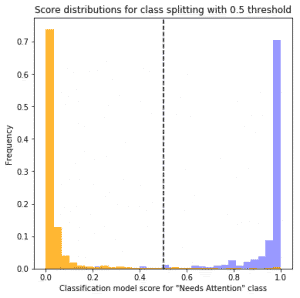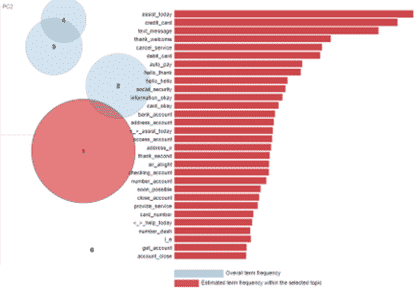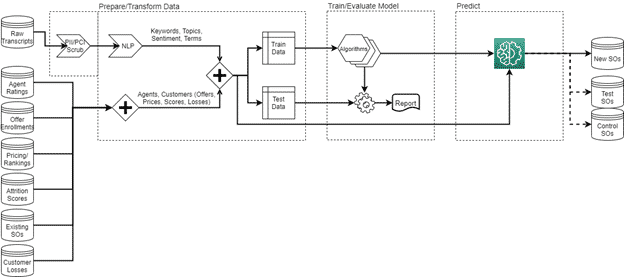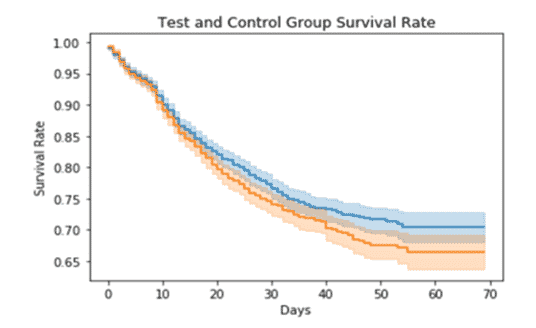Summary
Mosaic used complex natural language processing algorithms to automatically extract various insights about people calling into a customer call center. These insights were used to queue the client’s customer service team and inform customer churn. Call center NLP solutions are a powerful tool for any customer service team.

Take Our Content to Go
The Promise of NLP in Automating Call Center Insight Extraction
Studies have shown that most customers calling into a contact center are unhappy with typical Interactive Voice Response interactions. According to a report by Small Business Trends, more than 60% of consumers say IVR creates a poor experience. Natural Language Processing (NLP) solves this problem by giving consumers more options without forcing them into limited options.
The key to effective deployment of artificial intelligence (AI) in contact center solutions is NLP. NLP offers many benefits, including improving workplace efficiency and decreasing human capital costs. NLP can help intelligently route callers to the agents with the right skill set for the issues they are calling about for inbound calling. Intelligent routing produces faster resolution by matching agents and surfacing the proper scripts.
Human speech can be complex, especially when you add in regional differences. NLP works by breaking down speech and written words in multiple ways, such as syntax, semantics, and sentiment. Examining syntax helps uncover the words and phrases consumers use to determine the proper course of action. Analyzing the semantics can decipher the intent and meaning behind the words.
Understanding the sentiment involved in a contact can be a significant component of customer experience and retention in call centers. AI-enhanced natural language processing can tell if a customer is angry or frustrated. These calls may be prioritized, routed to retention specialists, or flagged for intervention.
The right contact center software can track and match contacts to previous interactions. Agents know who they are dealing with and what level of frustration customers are displaying in real-time. This can help prepare agents better and adjust their tone as needed. AI and NLP can also produce different scripts or resource materials for agents based on customer sentiment.

Use Cases and Benefits
Everyone benefits when you can resolve customer support issues without engaging an agent. Self-service options using NLP work 24/7 and don’t take breaks or call in sick. Research shows that auto-attendants, chatbots, and other self-serve options can save companies as much as 30% of their customer support budgets and speed up response times by as much as 80% for routine questions.
Auto-Attendants
One of the most significant benefits of natural language processing at call centers is resolving customer issues with specific information using auto-attendants. For example, an automated system can provide the customer with a particular answer regarding their account without sitting through multiple IVR menu options or requiring an agent to look up the information. This leads to more agent productivity and cutting costs.
Customer Service
In addition, intelligent routing involves interpreting consumer intent using natural language processing. This can not only get the call to the best available agent to handle the inquiry, but it can also produce the script and available options for the agent, making for a smoother customer service experience.
Omnichannel Support
Another benefit of NLP is its ability to handle queries similarly whether they arrive by voice, text, email, chat, or social media channels. With the right contact center software and call center dashboard, agents can also offer omnichannel support with the same efficiency.
Call Record Data Analytics
NLP can also be used for call record data analysis. Rather than spot-checking calls for agents, your contact center software can deploy natural language processing to sort through large numbers of calls, texts, and customer interactions. Not only can this help businesses to assess agent performance, but this data can also help make their NLP more efficient as the pool of data grows.
Customer Retention
Finally, NLP can also help with customer retention. Faster resolution is a hallmark of providing a positive customer experience. The longer consumers must wait on hold or to receive a response and resolution to an email or test, the more satisfaction scores will suffer.
Sentiment analysis allows organizations to study consumer churn rates by analyzing customer experiences during interactions. With this data, organizations can more quickly recognize the warning signs that lead to customer churn so that agents can address them more effectively. This is what Mosaic set out to accomplish with our energy client.
Customer Experience Use Case | Extracting Value from Transcripts
Mosaic’s customer is a leading retail energy company. The organization provides utility services to millions of residential & business customers. The customer care organization has a large mandate on meeting customer needs over time in a sustainable, innovative, and competitive manner. The organization had invested in capturing every customer call in stereo transcription (caller separate from agent) text files to reach this goal. The organization believed this unstructured text data held incredible value to improving the process and performance of call center representatives and customer satisfaction. They lacked the deep learning expertise to uncover insights from this data and determine the best customer experience use cases to inform. The firm desired to know if they could diagnose early indicators of customer churn and use that information to retain customers.
Mosaic was the ideal data science partner for this effort. Mosaic’s deep experience applying machine learning tools to critical business decisions enables Mosaic to support and enhance the energy firm’s efforts to use the recently acquired transcript data to drive improved operational and strategic decisions. Mosaic has developed and deployed advanced segmentation, retention models, and Natural Language Processing (NLP) decision support capabilities for several customers.
Topic Modeling
In collaboration with our customer, it was decided that topic modeling would be a good tool for exploring the customer call data. Topic models can help to identify what topic each customer call is about without having to manually read the transcripts. This technique is useful because manual identification of topics is not feasible when working with large text corpuses. The topics identified through topic modeling can also be used as input for downstream tasks such as predicting churn.
Mosaic built unique topic models for the customer care team to determine which topics were discussed most in different interactions. Examples of interactions analyzed included discussions about payments and payment problems, rate & plan discussions, service/maintenance discussions, and discussions about new plans (e.g., moving & pricing of service at a new location).

Deep Learning/Transformer Model
Mosaic used powerful deep-learning-based transformer models such as BERT to convert customer call text data into a numerical representation (embeddings) that captured the semantic meaning of the call. Pretrained transformer models were finetuned to be applicable to the customer’s data. The numerical representation of the text data could then be used in downstream tasks such as predicting churn.
After the energy customer had seen success with this deep learning approach and had time to evaluate the insights; it was decided, with Mosaic’s input, to try and inform indicators of customer churn using this data. The customer care team also wanted to test intervention strategies based on a controlled experiment to see how effective they could be at combatting churn.
Churn Prediction
Mosaic used the embeddings produced by the deep learning/transformer model, the topic distributions produced by the topic modeling, and other caller specific metadata that was available, to develop several classification models for predicting churn. A random forest model was able to predict which customers would discontinue with high accuracy and sensitivity and was selected as the final model for this classification task.
Now armed with the ability to identify which customers were at risk of discontinuing their service, the customer care team needed to determine how effective their intervention programs could be. Mosaic provided guidance on setting up the experimental design for an A/B testing to determine the efficacy of intervention programs.

Test-n-Learn (A/B testing)
All customers selected for the A/B testing experiment had called the center the previous day. Based on the previous day’s call transcripts, the churn model identified those with a high attrition risk. Analytics then filtered the list of customers based on those who have pending move-outs (e.g., a customer moving to an area not covered by the energy company) and swaps (e.g., switching from one type of energy to another) as well as have been targeted by any other intervention campaigns. The remaining customers were therefore incremental and would not have been identified with any existing intervention campaigns. These customers were split into test and control groups for A/B testing to test how effectively the intervention campaign could reduce churn among customers identified to be at high risk of attrition.

Results
The NLP models proved valuable to automate the process of identifying high churn risk customers. There was an estimated 23% lift in identifying potential churn using these new insights.
Contact centers are deploying natural language processing as a core component of their customer support. NLP is being integrated cross-channel to provide a consistent customer experience. Using NLP, the energy company can identify incremental at-risk customers & test intervention strategies, which applies to any company trying to streamline customer experience.


